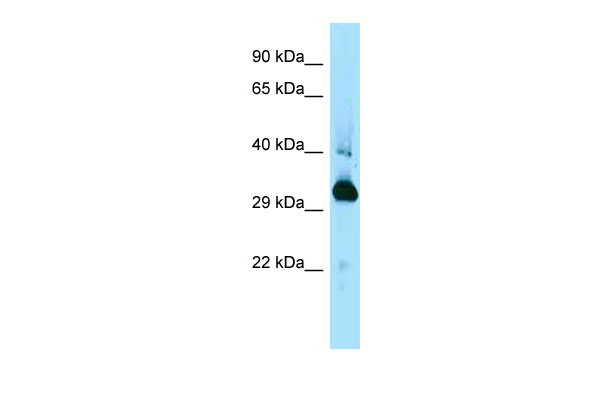Mapre1 antibody - C-terminal region
Rabbit Polyclonal Antibody
- 产品详情
- 实验流程
Application
| WB |
|---|---|
| Primary Accession | Q61166 |
| Other Accession | NM_007896, NP_031922 |
| Reactivity | Human, Mouse, Rat, Rabbit, Goat, Dog, Guinea Pig, Horse, Bovine |
| Predicted | Mouse, Pig, Dog |
| Host | Rabbit |
| Clonality | Polyclonal |
| Calculated MW | 30016 Da |
| Gene ID | 13589 |
|---|---|
| Alias Symbol | 5530600P05Rik, AI462499, AI504412, AW260097, BIM1p, D2Ertd459e, Eb1 |
| Other Names | Microtubule-associated protein RP/EB family member 1, APC-binding protein EB1, End-binding protein 1, EB1, Mapre1 |
| Format | Liquid. Purified antibody supplied in 1x PBS buffer with 0.09% (w/v) sodium azide and 2% sucrose. |
| Reconstitution & Storage | Add 50 ul of distilled water. Final anti-Mapre1 antibody concentration is 1 mg/ml in PBS buffer with 2% sucrose. For longer periods of storage, store at 20°C. Avoid repeat freeze-thaw cycles. |
| Precautions | Mapre1 antibody - C-terminal region is for research use only and not for use in diagnostic or therapeutic procedures. |
| Name | Mapre1 |
|---|---|
| Function | Plus-end tracking protein (+TIP) that binds to the plus-end of microtubules and regulates the dynamics of the microtubule cytoskeleton. Recruits other +TIP proteins to microtubules by binding to a conserved Ser-X-Leu-Pro (SXLP) motif in their polypeptide chains. Promotes cytoplasmic microtubule nucleation and elongation. Involved in mitotic spindle positioning by stabilizing microtubules and promoting dynamic connection between astral microtubules and the cortex during mitotic chromosome segregation. Assists chromosome alignment in metaphase by recruiting the SKA complex to the spindle and stabilizing its interactions with microtubule bundles (K-fibers). Also acts as a regulator of minus-end microtubule organization: interacts with the complex formed by AKAP9 and PDE4DIP, leading to recruit CAMSAP2 to the Golgi apparatus, thereby tethering non-centrosomal minus-end microtubules to the Golgi, an important step for polarized cell movement. Promotes elongation of CAMSAP2-decorated microtubule stretches on the minus-end of microtubules. Acts as a regulator of autophagosome transport via interaction with CAMSAP2 (By similarity). Functions downstream of Rho GTPases and DIAPH1 in stable microtubule formation (PubMed:15311282). May play a role in cell migration (PubMed:15311282). |
| Cellular Location | Cytoplasm, cytoskeleton. Cytoplasm, cytoskeleton, microtubule organizing center, centrosome {ECO:0000250|UniProtKB:Q15691} Cytoplasm, cytoskeleton, spindle {ECO:0000250|UniProtKB:Q15691} Cytoplasm, cytoskeleton, spindle pole {ECO:0000250|UniProtKB:Q15691} Note=Associated with the microtubule network at the growing distal tip of microtubules (PubMed:21357749). In addition to localizing to microtubule plus-ends, also exhibits some localization along the length of the microtubules (By similarity). Also enriched at the centrosome (By similarity). {ECO:0000250|UniProtKB:Q15691, ECO:0000269|PubMed:21357749} |
| Tissue Location | Expressed within the midpiece of sperm tail (at protein level). |
Research Areas
For Research Use Only. Not For Use In Diagnostic Procedures.
Application Protocols
Provided below are standard protocols that you may find useful for product applications.
REFERENCES
Sparks A.B.,et al.Submitted (MAR-1996) to the EMBL/GenBank/DDBJ databases.
Bienvenut W.V.,et al.Submitted (FEB-2008) to UniProtKB.
Wen Y.,et al.Nat. Cell Biol. 6:820-830(2004).
Wu X.,et al.Cell 135:137-148(2008).
Fong K.W.,et al.Mol. Biol. Cell 20:3660-3670(2009).
终于等到您。ABCEPTA(百远生物)抗体产品。
点击下方“我要评价 ”按钮提交您的反馈信息,您的反馈和评价是我们最宝贵的财富之一,
我们将在1-3个工作日内处理您的反馈信息。
如有疑问,联系:0512-88856768 tech-china@abcepta.com.























 癌症的基本特征包括细胞增殖、血管生成、迁移、凋亡逃避机制和细胞永生等。找到癌症发生过程中这些通路的关键标记物和对应的抗体用于检测至关重要。
癌症的基本特征包括细胞增殖、血管生成、迁移、凋亡逃避机制和细胞永生等。找到癌症发生过程中这些通路的关键标记物和对应的抗体用于检测至关重要。 为您推荐一个泛素化位点预测神器——泛素化分析工具,可以为您的蛋白的泛素化位点作出预测和评分。
为您推荐一个泛素化位点预测神器——泛素化分析工具,可以为您的蛋白的泛素化位点作出预测和评分。 细胞自噬受体图形绘图工具为你的蛋白的细胞受体结合位点作出预测和评分,识别结合到自噬通路中的蛋白是非常重要的,便于让我们理解自噬在正常生理、病理过程中的作用,如发育、细胞分化、神经退化性疾病、压力条件下、感染和癌症。
细胞自噬受体图形绘图工具为你的蛋白的细胞受体结合位点作出预测和评分,识别结合到自噬通路中的蛋白是非常重要的,便于让我们理解自噬在正常生理、病理过程中的作用,如发育、细胞分化、神经退化性疾病、压力条件下、感染和癌症。






